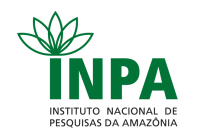Corpo Discente - Egressos
Sônia Maria Lima Santos do Vale
| Título | ISOLAMENTO, CARACTERIZAÇÃO DE BACTÉRIAS ENDOFÍTICAS DE Guadua spp. E AVALIAÇÃO DE USO NA PROMOÇÃO DE CRESCIMENTO DE Dioscorea cayenensis subsp. rotundata (Poir.) J. Miège | ||||||||||||||||||||||||
| Data da Defesa | 10/12/2020 | ||||||||||||||||||||||||
| Download | Em sigilo | ||||||||||||||||||||||||
Banca
| |||||||||||||||||||||||||
| Palavras-Chaves | solubilização de fosfato, fixação de nitrogênio, ácido indolacético, Bacillus lehensis, Enterobacteriaceae. | ||||||||||||||||||||||||
| Resumo | Os microrganismos endofíticos apresentam grande diversidade genética, sendo muito úteis para a agricultura, por produzirem reguladores de crescimento e disponibilizar nutrientes às plantas. Nesse contexto, esta pesquisa teve como objetivo isolar e caracterizar bactérias endofíticas do bambu Guadua spp., a fim de avaliar o efeito desses microrganismos na promoção de crescimento vegetal em plantas de Dioscorea cayenensis subsp. rotundata (Poir.) J. Miège. Para o isolamento dos microrganismos endofíticos, foram utilizados 10 ramos com folhas de cada indivíduo de Guadua weberbaueri e Guadua aff. chaparensis, os quais foram lavados com detergente e água corrente para retirada dos sedimentos. Em câmara de fluxo laminar, foi feita a desinfestação do material vegetal por imersão em álcool 70% por 1 minuto, hipoclorito de sódio a 2,5% por 3 minutos e álcool 70% por 1 minuto, seguido de lavagem em água esterilizada por duas vezes. Após a desinfestação, as folhas e os caules foram cortados em fragmentos de 0,5cm2 e 0,5cm, respectivamente, para a semeadura em meio de cultivo. Os fragmentos vegetais foram inoculados em placas de Petri contendo os meios de cultivo caldo Triptona de Soja (TSB) com extrato vegetal preparado com folhas de bambu e TSB sem extrato, Luria-Bertani (LB) com extrato vegetal de folhas de bambu e LB sem extrato, e acrescentados aos meios de cultivo 50 µg/mL do antifúngico Cercobin 700. Foram colocados 5 fragmentos do material vegetal nos meios de cultivo, por placa de Petri, e cultivados a 28°C em B.O.D, por 15 dias para crescer. As colônias em crescimento foram repicadas para outras placas, sendo purificadas pelo método de estrias por esgotamento em meio de cultura TSB 10%. Foram estudadas as características macromorfológicas das colônias bacterianas como forma, bordas, consistência, cor, brilho, e a análise micromorfológica foi feita pelo método de Gram. Foram realizados testes biológicos de solubilização de fosfato, fixação biológica de nitrogênio e produção de ácido indolacético, e as três bactérias com os melhores resultados nos testes biológicos, foram selecionadas para avaliar o potencial de promoção do crescimento de plantas micropropagadas de inhame branco. O experimento de crescimento constou de quatro tratamentos, com uma testemunha (sem inoculação) e três tratamentos com bactérias endofíticas, inoculadas em plantas de inhame branco. Cada tratamento consistiu em 6 repetições com 5 plantas por parcela, totalizando 30 plantas por tratamento. Foram isoladas 289 bactérias de fragmentos de folha e caules de Guadua spp. As colônias bacterianas apresentaram padrões semelhantes de características morfológicas para os três locais de coleta, com características como formato "circular", borda "inteira", consistência "cremosa", cor "marrom" e brilho "brilhante". Verificou-se que 39,1% das bactérias foram capazes de realizar a solubilização do fosfato, 61,9% realizaram a fixação do nitrogênio atmosférico e 26,9% realizaram a síntese do ácido indolacético. Em relação à promoção de crescimento, a testemunha diferiu estaticamente dos outros tratamentos com aplicação das bactérias endofíticas, apresentando maior incremento médio de biomassa úmida total (3,93g) e biomassa úmida de raiz (1,0g), porém o isolado 1691 foi estatisticamente relacionado com a testemunha, demostrando que a atividade fisiológica das bactérias da família Enterobacteriaceae pode influenciar a produção de biomassa fresca pelas plantas de inhame. Os dados de massa seca deste trabalho mostraram que as bactérias testadas não foram eficientes em aumentar o acúmulo de massa seca pelas plantas de inhame branco, demonstrando que o tratamento controle foi mais eficiente que os tratamentos com adição das bactérias endofíticas do bambu Guadua spp. | ||||||||||||||||||||||||
| Abstract | Endophytic microorganisms have great genetic diversity, being very useful for agriculture, as they produce growth regulators and make nutrients available to plants. In this context, this research aimed to isolate and characterize endophytic bacteria from the Guadua spp., in order to evaluate the effect of these microorganisms in the promotion of plant growth in Dioscorea cayenensis subsp. rotundata (Poir.) J. Miège. For the isolation of endophytic microorganisms, 10 leafy branches of each individual from Guadua weberbaueri and Guadua aff chaparensis were used., which were washed with detergent and running water to remove sediment. In a laminar flow chamber, the plant material was disinfected by immersion in 70% alcohol for 1 minute, 2.5% sodium hypochlorite for 3 minutes and 70% alcohol for 1 minute, followed by washing in sterile water for two minutes. After disinfestation, the leaves and stems were cut into 0,5 cm2 and 0,5 cm fragments, respectively, for sowing in culture medium. The vegetable fragments were inoculated in Petri dishes containing the culture media Soy Triptona broth (TSB) with vegetable extract prepared with bamboo leaves and TSB without extract, Luria-Bertani (LB) with vegetable extract of bamboo leaves and LB without extract, and 50 µg / mL of the antifungal Cercobin 700 were added to the culture media. Five fragments of plant material were placed in the culture media, per Petri dish, and cultured at 28 ° C in B.O.D, for 15 days to grow. The growing colonies were seeded to other plates, being purified by the streak method by depletion in TSB 10% culture medium. The macromorphological characteristics of the bacterial colonies were studied, such as shape, borders, consistency, color, brightness, and the micromorphological analysis was performed using the Gram method. Biological tests for phosphate solubilization, biological nitrogen fixation and indoleacetic acid production were carried out, and the three bacteria with the best results in biological tests were selected to assess the growth promotion potential of white yam plants. The growth experiment consisted of four treatments, with one control (without inoculation) and three treatments with endophytic bacteria, inoculated in pre-acclimated yam plants. Each treatment consisted of 6 repetitions with 5 plants per plot, totaling 30 plants per treatment. 289 bacteria were isolated from leaf fragments and stems of Guadua spp. The bacterial colonies showed similar patterns of morphological characteristics for the three collection sites, with characteristics such as "circular" shape, "entire" border, "creamy" consistency, "brown" color and "bright" luster. It was found that 39,1% of the bacteria were able to solubilize the phosphate, 61,9% performed the fixation of atmospheric nitrogen and 26,9% performed the synthesis of indoleacetic acid. In relation to growth promotion, the control differed statically from other treatments with the application of endophytic bacteria, presenting a higher average increase in total wet biomass (3,93g) and wet root biomass (1,0g), however the isolated 1691 was statistically related to the control, demonstrating that the physiological activity of bacteria from the Enterobacteriacea family can influence the production of fresh biomass by yam plants. The dry mass data of this work showed that the tested bacteria were not efficient in increasing the dry mass accumulation by the white yam plants, demonstrating that the control treatment was more efficient than the treatments with the addition of the endophytic bacteria of the Guadua spp. | ||||||||||||||||||||||||
Parceiros

























